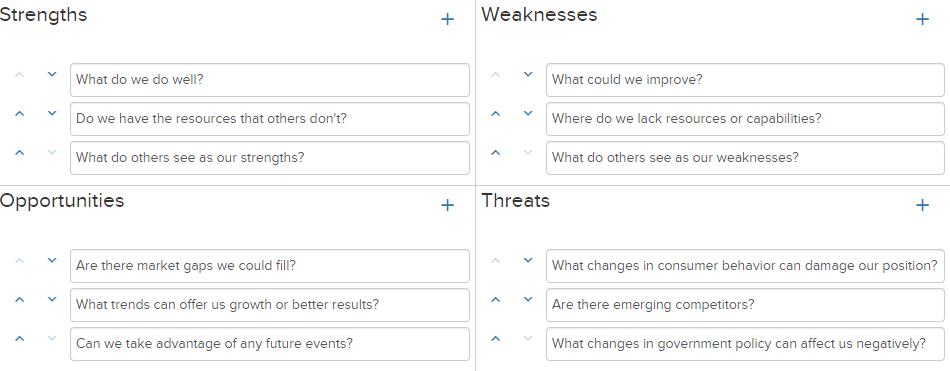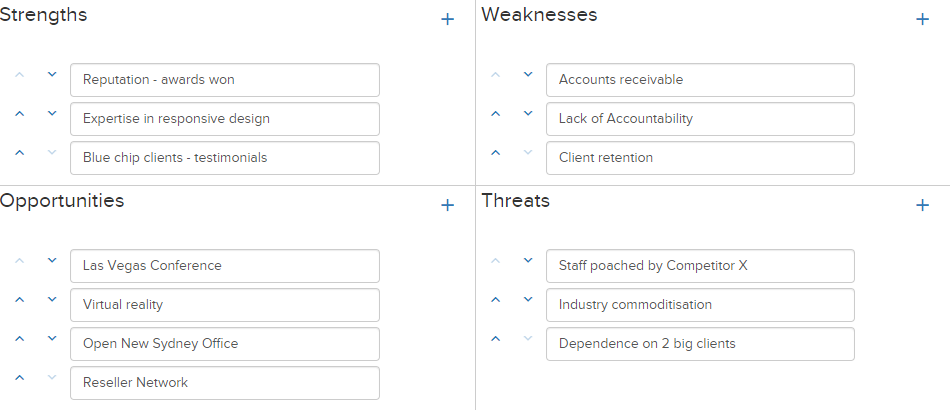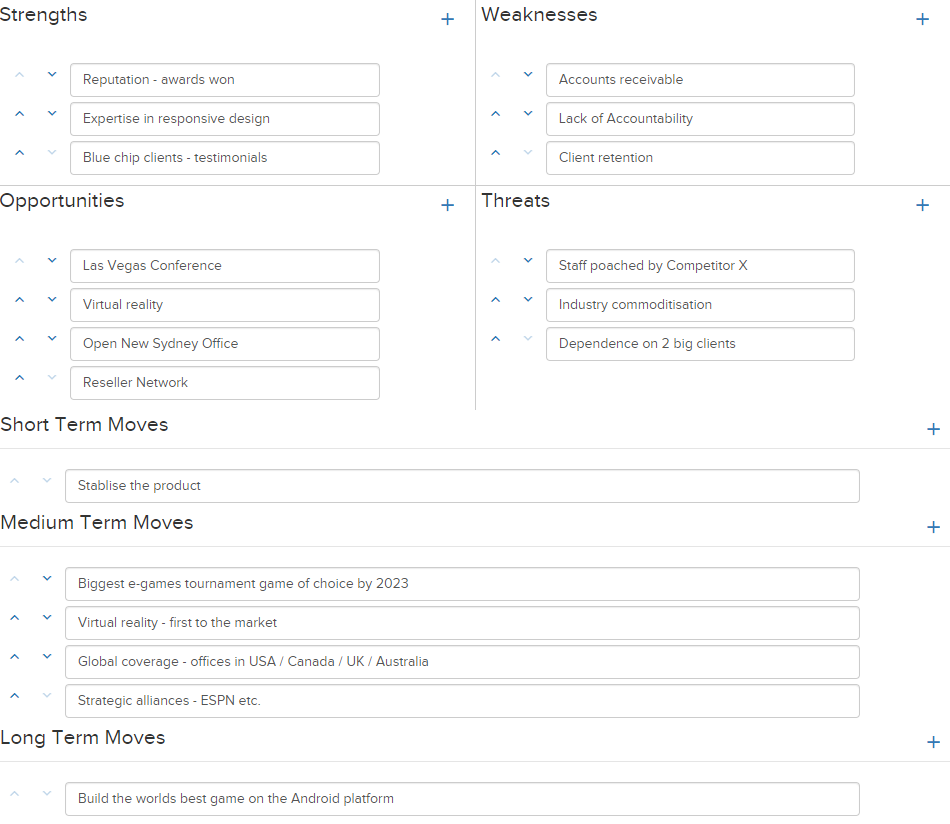Many of you will have come across the term "SWOT analysis." This is where a business takes the opportunity for a hard, honest reflection at itself.
Conducting a SWOT analysis is a powerful way to evaluate and can be applied in many aspects of business and economics. It’s a basic yet extremely useful tool to evaluate a company, organization, project, or strategy looking to be implemented, whether you’re two people or 500 people. At it’s core, a SWOT analysis is an overview of both the external and internal factors and drivers that affect a company, in the present and the foreseeable future.
Put very simply, it’s a honest study of reality (fact-based data), reflected in an organized list of key Strengths, Weaknesses, Opportunities, and Threats that affect whatever you’re analyzing. In this sense, it’s the perfect first step in many strategic plans and decision-making process.
In this article, you’ll learn what a SWOT analysis is, see some SWOT analysis examples, and learn tips for conducting a comprehensive SWOT analysis within Strategy-AI's planning toolkit.
What Is a SWOT Analysis?
Definition: A SWOT analysis (Strengths, Weaknesses, Opportunities and Threats) is a planning exercise that helps you identify the main internal and external factors that affect an organization, business, or project. The aim is to assess, the positives to leverage and negatives to mitigate making the most out of your current position. This is done by understanding what you have and can take advantage of along with what you’re lacking and should avoid. In many situations, this is best approached as assessing performance, competition, risk, and potential of the company, department, team or project being evaluated.
Strengths and weaknesses are internal to the organization so they may be managed directly by it. By comparison, opportunities and threats are external factors, the company must influence and respond to. This is a broad analysis, so these categories can hold a very wide range of factors.
In the Strategy-AI planning toolkit, this is presented as a 4 quadrant matrix, each segment corresponding to one of the four categories. This layout is an intentionally helpful visual representation for a better present the company’s position. This will help you quickly ascertain the overall situation of your product, project or business; highlighting the factors in play. Internal factors are in the first row and external elements below them. In the same way, the 2 quadrants on the left are beneficial or positive aspects to the company, while the ones on the right side affect negatively on your organization.

Breaking Down the SWOT Analysis Process
Strengths
These are the internal factors that benefit you and make you excel over your competition. Strengths are what makes it possible for your product, department or company succeed, both by being better than others and by overcoming adversities when others are better than you (offense and defense). This can contain factors such as: processes to employees, products, investments, results… You could start by looking at your resources, assets, unique competencies and capabilities, functional areas, or value chain activities.
Tip: Here are some specifics you could ask:
- What assets (tangible, intangible) do we possess that are valuable to the company or our consumers?
- Is there anything we do better than the competition?
- Are there any genuine advantages we can exploit that are difficult to replicate by competitors or other products?
- What do other products or company’s lack that we don’t?
- What makes us unique?
- Where do we beat other companies? What do they see as our strengths?
Weaknesses
Weaknesses are inherent negative attributes that detract from your strengths, making the organization or products fall behind their full potential. They stop the organization from performing at its best and can be both current burdens (financial, technological, human…) or a lack of certain characteristics and resources. Overall, you’re looking to identify the elements that are causing setbacks and those you should overcome and mitigate to boost your competitiveness.
Like strengths, weaknesses can appear in many shapes and forms inside your company: financial limitations, low performing production process, poor brand awareness… So look out for them in every aspect of your organization (systems, procedures, policies, branches, departments, activities etc.).
Tip: Here are some specifics you could ask:
- What areas of the company are under-performing?
- Does the team lack the required set of skills and capabilities?
- What do consumers value the least in our product?
- Are we lacking anything that competitors have (assets, resources)?
- What is making us not differentiate?
- What do competitors see as our main weakness?
Opportunities
Opportunities are mostly external factors to your business environment that you can take advantage of and act upon. They usually appear outside the company (a new market gap, tariffs cuts in a geographic region you operate in), but they can also be a result of your activity as it creates future circumstances that you can exploit (developing partnerships or new markets to pursue).
When thinking about opportunities you should consider what is happening right now that will affect the environment or industry in the future in a way that you could use in your favor (to increase sales, grow, advance on your mission, or develop your competitive advantage). In this sense, study your competition and broader market changes that may be happening around you:
Tip: Here are some specifics you could ask:
- What trends are succeeding in our (and adjacent) industry and the market?
- Are there upcoming changes in government policies or events that we can take advantage of?
- Can we leverage our resources to get better results?
- Do we have products or features that are being underutilized or could have a fast-growing demand if repackaged?
- Is there anything that could help us stand out from your competition in the future?
- Can we spot changes in social patterns or population profiles?
Threats
These are external factors you have little or no control over and can negatively affect your organization. Threats have the power of potentially damaging your projects and product, whether they emerge from industry competitors or other external forces. Though they maybe outside your control, you can choose how to mitigate their impact or respond to them as long as you are prepared. In fact, you may be able to predict and handle them in a way that turns them into an opportunity.
They can appear suddenly (like a pandemic outbreak), which is why you should set aside resources to put in place contingency plans; but they may be a result of longer on-going tendencies in an industry (a downward trend in the demand for certain products or services or an increasing number of competitors).
Tip: Here are some specifics you could ask:
- Will there be new competitors in our market?
- Is our industry going through a volatile period or recession?
- Has consumer behavior and their needs changed?
- Are there any changes in regulation that could affect our environment?
- Can problems emerge in our supply chain?
Should a Small Business Conduct a SWOT Analysis?
If you’re a marketer or small-business owner, you might be wondering if a SWOT analysis in practical or even feasible for smaller companies, organizations or departments. Although there is definitely a resource overhead involved in the creation of a SWOT analysis, there are many benefits in doing so, even for the smallest of companies.

Image via Fundera.
For one, conducting a comprehensive SWOT analysis provides a unique opportunity to gain greater insight into how your business operates. It’s all too easy to get lost in the weeds of the day-to-day workings of your company, and conducting a SWOT analysis allows you to take a broader, high level look at your business and it's current position in your market.
Obviously, it almost goes without saying that conducting a SWOT analysis allows you to identify what your company does well, where it could improve, and the opportunities and threats facing your business. However, conducting a SWOT analysis provides you with the opportunity to not only identify these factors, but also develop and implement tangible roadmaps and timelines for potential solutions. This can be beneficial in the creation of budgetary plans, identifying hiring needs, and leads to building your short, medium and long-term strategic objectives and initiatives.
Steps and tips for the best SWOT analysis
Here are some steps and tips you can use for a successful SWOT analysis:
- Two heads think better than one. Gather people that have good knowledge about the different departments or teams in the company. It might be a good idea to ask an outsider or advisor for their opinion on different topics. Having fresh, outside the box opinions that are not biased by your thoughts and experience inside the organization can be useful. Don’t go overboard with the number though or paralysis can set in.
- Make it rain in your brain. Techniques for brainstorming can be very useful to start a SWOT analysis. Before you all meet, have everyone individually go over each of the quadrants identifying their own ideas privately to avoid group think. When you do convene everyone for the planning session; have each person present their ideas, being prepared to elaborate a little of their ideas.
- Do the math: add, subtract, divide and multiply. Here’s where you compose a serious first draft of your SWOT analysis. If this is your first planning session, create a new plan in Strategy-AI using the "General" template, if this session is to update your existing plan, open the plan for editing. Consider adding each new ideas into it's respective quadrant and evaluate them individually and as a whole. Many may be related to each other and some can be causes or consequences of others, while others shouldn’t be in the plan at all. Discuss these matters: add new ideas, discarding new ideas you don’t need, divide concepts, or expand and multiply others. Do this collectively, make use of a voting system if needed.
Main guidelines to follow
Any way you want to do it, take into account the following guidelines to get the best plan:
- Define items clearly and be specific. You need to get the general idea behind each factor just by taking a quick look at the analysis. Get the most amount of information in one sentence.
- Rely on facts. Items need objective measurable truths that you can pinpoint, or links to data that will let you know exactly what’s going on. You should be able to know if there’s data that needs to change and what elements you have to modify. A good KPI system is crucial to get the best results out of any analysis.
- As we said before, factors have to be studied relative to your environment, especially your competitors. You won’t be able to organize your factors and place them on the correct quadrant without benchmarking your data.
- Try to keep your SWOT analysis short and simple – at least at first glance. Avoiding more than eight items per category. However, you may expand on these ideas further to get a better understanding of what they imply and how to deal with them.
Here’s an example of how a SWOT analysis might look, in this case for a video games studio:

How to Act Upon Your SWOT Analysis
So, you’ve compiled your SWOT matrix. You’ve identified internal strengths and weaknesses, as well as external opportunities and threats. You’ve begun to see your company in a whole new light.
Now what? Discuss the initiatives and projects that leverage your strengths and opportunities as well as mitigate and address the weaknesses and threats.
Acting On Your Strengths
One of the best things about the strengths you identified in your SWOT analysis is that you’re already doing them.
In our example above, the game studio has great "responsive design". This tells the fictitious company that it should continue to utilize that skill to do experiments as it pursues the opportunities in Virtual Reality as a Medium Term Move.
Essentially, acting upon your business’ strengths consists of “do more of what you’re already good at.”, especially to pursue your opportunities.
Shoring Up Your Weaknesses
Acting on the weaknesses you identified in your SWOT analysis is a little trickier, not least because you have to be honest enough with yourself about your weaknesses in the first place.
Going back to our example, some of these weaknesses are very challenging to act upon. Going up against the considerable purchasing power of a main stream rival studio that you are loosing clients to can be very difficult for smaller businesses.
However, that’s not to say all hope is lost. It might be harder for our example business to compete with a main stream studio, but there are plenty of other ways small companies can be more competitive – such as by developing strong, interactive relationships with customers, which, while not only one of the company’s strengths, is something larger studio simply cannot act on. In this example, stabilizing the engine games are built on will help address customer churn as a Short Term Move.
Seizing Opportunities
The Opportunities section of your SWOT analysis is by far the most actionable, and that’s by design. By identifying opportunities and leveraging your organization’s strengths, you should have a ready-made list of targets to aim for.
In the example above, nurturing and building a reseller network is a major opportunity that could increase revenue to address the weakness of accounts receivable and client retention. This can be done by making Strategic Alliances such as with ESPN a Medium Term Move. However, the executive team cannot rest on their laurels – there’s still work to be done. In this example, this may involve investing in partner management expertise to take advantage of the opportunity.
It’s also important to avoid hubris or complacency in your opportunities. Even if you have an iron-clad advantage over every other business in your industry, failing to devote sufficient time, money, or personnel resourcing in maintaining that advantage may result in you missing out on these opportunities over time.
Every business’ opportunities will differ, but it’s vital that you create a clearly defined roadmap for capitalizing upon the opportunities you’ve identified, whether they be internal or external.
Mitigating Threats
Anticipating and mitigating the threats identified in your SWOT analysis may be the most difficult challenge you’ll face in this scenario, primarily because threats are typically external factors; there’s only so much you can do to mitigate the potential damage of factors beyond your control.
Every threat, and the appropriate reaction to that threat, is different. Regardless of the specific threats you’ve identified in your SWOT analysis, responding to and monitoring those threats should be among your very top priorities, irrespective of the degree of control you have over those threats.
In the example above, having a dependency on just 2 large customers is particularly challenging. To mitigate their influence from these two large customers on the games and direction the company wants to follow can also be addressed with Strategic Alliances to build a larger client base as a Medium Term Move.

In some SWOT analyses, there may be some overlap between your different items in each segment. As an example, in the analysis and examples highlighted, the identified Medium Term Move Strategic Alliances worked towards leveraging an opportunity while also addressing a threat to the business.
When compiling the moves your business wants to pursue, be sure to look for areas of crossover like this and see if it’s possible to seize an opportunity and reduce a threat at the same time.
References:
- https://www.wordstream.com/blog/ws/2017/12/20/swot-analysis
- https://appfluence.com/productivity/the-ultimate-guide-to-swot-analysis-in-2021
